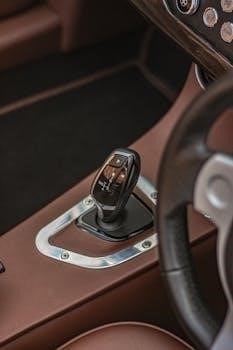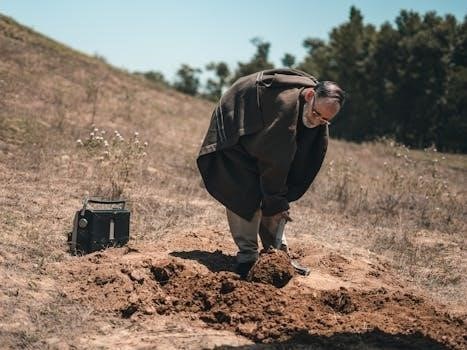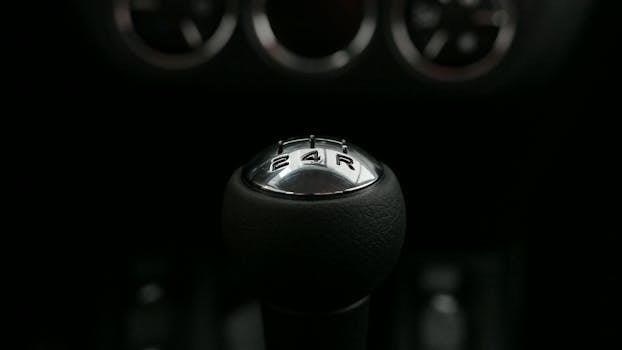Overview of Jeep JK Manual Transmission
The Jeep JK manual transmission, found in Wrangler models, is known for its robust design․ However, owners have reported issues like grinding gears, difficulty shifting, and clutch problems․ Addressing these promptly is essential for maintaining the vehicle’s performance and preventing extensive repairs․

Common Problems with JK Manual Transmissions
Jeep JK manual transmissions often suffer from several common issues․ These include grinding gears during shifts, difficulty engaging certain gears, clutch slippage under load, and the transmission popping out of gear․ These problems can affect the overall driving experience․
Grinding Gears
Grinding gears is a frequent complaint among Jeep JK manual transmission owners, indicating serious internal wear or synchronization issues․ This unpleasant sound and sensation usually occurs during gear shifts, particularly when shifting into second or third gear․ Several factors contribute to this issue․ Worn synchronizers, designed to match gear speeds during shifts, are a common cause, and low or contaminated transmission fluid can exacerbate the problem, as it reduces lubrication and increases friction between the gears․
Aggressive driving habits and high mileage contribute to premature wear of the transmission components․ Addressing gear grinding promptly prevents further damage to the transmission․ A mechanic should inspect fluid levels, synchronizers, and overall transmission health․ Ignoring grinding gears leads to costly repairs or a complete transmission replacement․ Regular maintenance helps mitigate the issue․
Difficulty Shifting
Difficulty shifting gears in a Jeep JK manual transmission points to underlying mechanical issues impacting the transmission’s smooth operation․ Drivers often experience resistance or stiffness when attempting to shift between gears, making driving less comfortable․ This can stem from several potential problems․ Low or degraded transmission fluid reduces lubrication, hindering the synchronizers’ ability to mesh gears smoothly․
Clutch issues, like a worn clutch disc or a malfunctioning clutch master cylinder, can prevent full disengagement, causing shifting difficulties․ Internal transmission component wear, such as bent shift forks or damaged gears, also contributes to this issue․ Diagnosing the root cause involves inspecting fluid levels, clutch components, and the internal transmission parts․ Timely repairs are critical to avoid escalating damage and ensure reliable shifting․
Clutch Slippage
Clutch slippage in a Jeep JK manual transmission manifests as a noticeable delay between engine speed and vehicle acceleration․ The engine revs higher than usual without a corresponding increase in speed, indicating the clutch is not fully engaging․ This can be particularly evident during acceleration or when climbing hills․ Common causes include a worn clutch disc, contaminated friction surfaces, or a weak pressure plate․
Over time, the clutch disc’s friction material wears down, reducing its ability to grip the flywheel effectively․ Oil or grease contamination on the clutch surfaces also diminishes friction․ Addressing clutch slippage requires replacing worn or contaminated components to restore proper engagement and prevent further damage to the transmission system․ Ignoring the issue can lead to complete clutch failure․
Popping Out of Gear
One of the more alarming issues with the Jeep JK manual transmission is when it unexpectedly pops out of gear․ This typically occurs while driving, causing a sudden loss of power and potential safety concerns․ Several factors can contribute to this problem, including worn synchronizers, damaged shift forks, or issues with the transmission’s internal components․ Owners have reported this happening in various gears, with some specifically noting problems with 1st and 4th․
Worn synchronizers can prevent gears from fully engaging, leading to them disengaging under load․ Damaged shift forks, responsible for moving gears into position, can also cause incomplete engagement․ Addressing this requires a thorough inspection of the transmission’s internal mechanisms to identify and replace any faulty parts, ensuring proper gear engagement and preventing recurrence․
Shifter Fork Assembly Issues
The shifter fork assembly plays a crucial role in the JK manual transmission, responsible for engaging and disengaging gears as the driver shifts․ Problems within this assembly can lead to various issues, including difficulty shifting, grinding noises, and, notably, the transmission popping out of gear․ Over time, the shifter forks can wear down or become damaged, impacting their ability to properly position gears․
Worn shifter forks may not fully engage the gears, causing them to slip out of position during operation, especially under load or when encountering bumps․ Issues with the shifter fork assembly are a known problem in rebuilt transmissions․ Addressing this requires a careful inspection of the assembly, replacing worn or damaged forks, and ensuring proper alignment to restore smooth and reliable shifting․
Dislodged Inner Shift Boot
A dislodged inner shift boot can cause significant problems in the Jeep JK’s manual transmission․ This boot, located around the gear shifter, helps maintain proper alignment and restricts movement within the transmission linkage․ When the inner shift boot becomes dislodged or damaged, it can interfere with the shifter’s range of motion, leading to issues like popping out of gear․
Specifically, the dislodged boot can exert pressure on the shift lever, causing it to partially disengage from the selected gear․ This is particularly noticeable when driving over bumps or under acceleration․ Correcting this issue typically involves inspecting the shift boot, ensuring it is correctly seated, and replacing it if damaged․ Ensuring the shift boot is secure can resolve gear-popping issues․

Potential Causes and Solutions
Several factors can lead to Jeep JK manual transmission problems․ These range from low fluid to clutch issues․ Solutions involve proper maintenance, addressing shift boot problems, and considering aftermarket upgrades for enhanced performance and reliability․
Low Transmission Fluid
Low transmission fluid is a common culprit behind various manual transmission issues in Jeep JK models; Maintaining the correct fluid level is essential for smooth operation and the longevity of the transmission․ When fluid levels drop, it can lead to several problems, including difficulty in shifting gears․ This occurs because the synchronizers, which rely on fluid lubrication to smoothly engage gears, do not function effectively without adequate fluid․
Furthermore, low fluid can cause increased friction between moving parts, leading to overheating and accelerated wear․ Over time, this can result in grinding noises during gear changes and, eventually, transmission failure․ Regularly checking and topping off the transmission fluid can prevent these issues․
Ensure you use the correct type of fluid as specified in the owner’s manual․ Addressing low fluid levels promptly can often resolve shifting problems and prevent more costly repairs․ Ignoring this simple maintenance task can lead to significant damage and expensive replacements․
Shift Kit and Boot Problems
Shift kit and boot problems can significantly impact the performance of a Jeep JK’s manual transmission․ Issues with the shift kit, which includes components like the shifter fork and related linkages, can lead to difficulties in selecting gears․ A worn or damaged shifter fork might not fully engage the gears, causing grinding or preventing the vehicle from shifting into gear altogether․ Similarly, problems with the shift boot, both the inner and outer boots, can lead to complications․
A dislodged or damaged inner shift boot is a known issue in JK models, often causing the transmission to pop out of gear, especially during deceleration or when hitting bumps․ The boot’s proper positioning is crucial for maintaining the correct alignment of the shifter mechanism․ Aftermarket modifications, such as body lifts, can exacerbate these issues by altering the geometry of the shifter linkage․
Regular inspection and maintenance of the shift kit and boots are vital to ensuring smooth and reliable transmission operation․ Replacing worn components and ensuring proper installation can prevent many common shifting problems․
Clutch Plate Issues
Clutch plate issues are a significant concern in Jeep JK manual transmissions, often leading to performance degradation and potential safety hazards․ Overheating of the clutch plate can cause it to explode, creating a fire risk, as highlighted in recent recalls․ This overheating typically occurs due to excessive slippage, often resulting from worn clutch material, improper adjustment, or aggressive driving habits․
Symptoms of failing clutch plates include slippage during acceleration, where the engine revs up without a corresponding increase in vehicle speed․ Difficulty shifting gears, particularly when the engine is under load, and a burning smell emanating from the clutch housing are also indicative of clutch plate problems․ Vibrations or a pulsating feeling in the clutch pedal can further suggest issues within the clutch assembly․
Addressing clutch plate issues promptly is crucial to prevent further damage to the transmission and ensure safe vehicle operation․ Replacing worn clutch plates with high-quality components and ensuring proper clutch adjustment are essential maintenance steps․

Aftermarket Upgrades and Solutions
For Jeep JK owners facing manual transmission issues, the aftermarket offers a range of upgrades and solutions designed to enhance performance and durability․ Upgraded clutch kits are a popular choice, providing increased torque capacity and improved heat resistance compared to stock components․ These kits often feature stronger pressure plates and more robust friction materials, addressing common problems like clutch slippage and premature wear․
Short throw shifters are another popular upgrade, offering a more precise and engaging shifting experience․ These shifters reduce the throw distance between gears, resulting in quicker shifts and a sportier feel․ Additionally, some aftermarket manufacturers offer improved shifter fork assemblies designed to address issues with popping out of gear, a known problem in JK transmissions․
Transmission coolers can also be beneficial, especially for JKs used for off-roading or towing․ These coolers help to dissipate heat and maintain optimal transmission fluid temperatures, extending the life of the transmission and preventing overheating․ Exploring these aftermarket options can significantly improve the performance and reliability of the Jeep JK manual transmission․

Maintenance and Prevention
Regular maintenance is crucial for preventing common Jeep JK manual transmission problems․ One of the most important aspects is maintaining the correct transmission fluid level․ Low fluid can lead to overheating and damage․ Regularly check the fluid level and condition, replacing it according to the manufacturer’s recommendations․ Using a high-quality transmission fluid can also extend the life of the transmission․
Proper shifting techniques can also help prevent wear and tear․ Avoid aggressive shifting, which can damage synchronizers and other internal components․ Ensure the clutch is fully engaged before shifting gears to minimize stress on the transmission․ Periodically inspect the shifter linkage and boots for any signs of damage or wear․ Replacing worn components can prevent issues like popping out of gear․
For JKs with body lifts, ensure the shift linkage is properly adjusted to avoid binding or interference․ Regularly inspect the clutch for signs of slippage or wear․ Addressing small issues promptly can prevent them from escalating into more significant and costly repairs․ By following these maintenance practices, you can keep your Jeep JK manual transmission running smoothly for years to come․